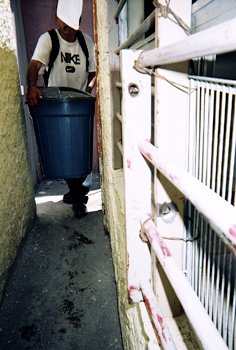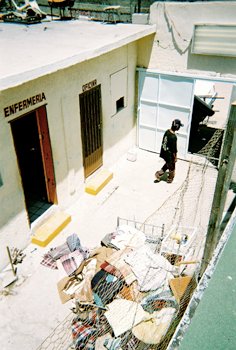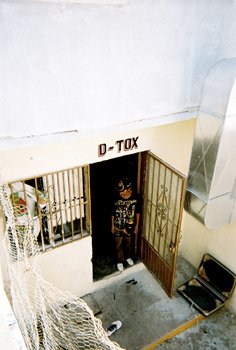


Massacre at CIAD #8 in Juárez
Masked Gunmen Unleash AK-47s on Drug-Rehab Center; Mexican Soldiers Parked 50 Yards Away Do Nothing
By Molly Molloy
Special to The Narco News Bulletin
August 18, 2008
The massacre took place at 7:15 Wednesday night, August 13, 2008 at the CIAD (Center for Drug and Alcohol Integration) Rehabilitation Center #8 in the Colonia First of September. It was the single most deadly violent incident in Juárez in recent times.
 Corner where 4 or 5 people were shot to death during religious service, CIAD #8 Photos D.R. 2008 Molly Molloy |
When the shooting stopped, bodies lay all over the room. The director of the center (who has not been identified in press accounts) lay with his body over another pastor’s wife. She and her unborn child survived. The man died. Joel Valles, 47, a deacon of the church, was also killed in the attack. Other witnesses reported that before commencing to shoot everyone in the room, the assassins dragged several people out to the patio, threw them face down and shot them at point blank range.
The gunfire went on for 15 minutes.
Media reports say that at least 8 (some say 9) people died at the scene. Five others were taken to the hospital with serious gunshot wounds, transported in the old van belonging to the rehab center because too much time went by before a Mexican Red Cross ambulance arrived. One young man, Luis Angel Gonzalez, was found lying dead at the nearby intersection of Zaragoza Boulevard and Avenida de los Aztecas. He lived in the house next door to the center and had begun to seek detox help there a week and a half earlier for his addiction to glue and solvents.
 Passage leading to the roof at CIAD #8, AK-47 bullet holes in the window frame |
“We are sure that the soldiers were guarding the killers or maybe they came with them so that the police would not be able to intervene. They had to have known what was going on because they passed right in front of the center.” The witness, quoted in the newspaper, asked not to be identified for fear of reprisals. The newspaper also said that an unnamed source inside the Mexican Army denied that the military had carried out any operation at the scene or that they were aware of what had happened. Later, municipal police cordoned off the area and offered no help to the wounded. By the afternoon, the eyewitness accounts of the army soldiers had disappeared from the English language wire reports.
Did I mention that the high caliber gunfire went on for 15 minutes?
I sit at my computer early Thursday morning and almost forget to check the Juárez papers as I’ve done compulsively nearly every day this year, trying to keep track of the unprecedented violence in the city. At the time I write in mid-August, the toll has climbed to nearly 840, more than 146 in the first 19 days of August alone. I’m jaded, addicted to the numbers, the tally, how many killed today, this week, this month, this year? The headline, *“Asesina comando a 9,”* wiped the callousness away. I grew up going to a tiny Baptist church. The idea of people mown down by gunfire during the “invitation” at a prayer meeting—this is evil. I contact a reporter working on the Juárez story.
The next morning we drive up to the high ground on the southwest side of the city, crowned on the side of a hill by the Cementos de Chihuahua plant. Some of the residents of CIAD #8 tried to escape the massacre by jumping over the fence in back of their building and ran toward the cement plant to hide. The truck feels tired even before we turn off the paved avenue onto the broken cement and gravel of Casa de Janos street. The CIAD building is painted white, in fact, we can barely see the shadow of the logo under its brand new whitewash. We are there less than 40 hours after the massacre and the place has already been shut down.
Next door is a house where some 40 people are gathered on chairs under a dirty canvas shelter. It is the wake for Luis Angel, the teenager left for dead on a nearby corner. His grandmother, Librada Limones, 79, saw his body on the street. “His head was very bad, his body was covered with blood. I got close to him but he no longer had any reaction. He stayed there a long time, they were going to take him to a clinic but they never made it and they left him there.” She was hospitalized with heart trouble the next morning.
 Patio at CIAD #8, August 15, 2008 |
When we go back out to the street, the metal gate in front of the CIAD #8 is open. Several vans with Sonora plates are parked haphazardly on the sidewalk. We walk through the gate into the patio. Several guys are up on the roof tossing bundles of plaid blankets from the dormitory upstairs down to the ground. The same blankets that often appear in murder stories in the newspaper, wrapping victims tossed into the streets. These bodies are known as “*encobijados*.” In the rooms are discarded sandals and odd shoes. Pill boxes tossed on the floor of the tiny clinic. Upstairs in the bedrooms are a few books and religious tracts, odd bits of clothing, towels, an empty cedar box that might have held something very personal, on the wall, a velvet painting of an Aztec eagle.
Workers dismantle metal bed frames and haul the pieces out to the vans. Eventually, they toss the blankets into garbage barrels on the street. The CIAD organization is based in Cananea, Sonora and operates a chain of rehab centers in the border region, including three centers in Juárez. On August 1, two men were shot and killed at another center and there were other warnings. One center had been closed and abandoned since last Sunday. Between 80-100 inmates scattered and workers erased their logos from the buildings and left clear messages on the walls: “This Center is leaving Cd. Juárez,” “This place is Closed” “We are leaving this city.” Inmates had traditionally raised money for their rehabilitation by selling candies and seeking donations at busy intersections all over the city. As of last week, other street vendors said that the reformed addicts had abandoned their posts. The men cleaning up on Friday at CIAD #8 were driving from Sonora on Wednesday to help in shutting down the remaining Juárez centers. They arrived 2 hours after the massacre. They also said that they had told the authorities that they were closing down and leaving town. They had asked the police and the army for protection. They arrived too late for CIAD #8.
 Gang graffiti in honor of Luis Angel, Casa de Janos Street, Colonia First of September, August 15, 2008 |
None of the guys working on Friday give their names, but they have no trouble with a couple of Americans being there while they work. In fact, they probably figure that as long as we are there, it is less likely the hooded men with AKs will return. The guy in charge from Cananea takes us into the Conference Room where at least 4 or 5 people died. It is about 30 feet long and perhaps 12 feet wide, painted white and dark yellow, an uneven floor of mismatched ceramic tiles of various colors. A dozen or more people attending the prayer service had tried to save themselves by running into the tiny bathroom at the back corner.
In the opposite corner, blood splatters and fingerprints smear the floor and wall, dark brown stains soak the seams between the tiles, chipped and cracked where the bullets hit. Flies buzz around us as we listen and write things in notebooks. The man said the bodies had piled up here and the blood pooled in this corner. Now a small crucifix leans against the wall, a red Virgen of Guadalupe candle burns down and someone has placed a burning cigarette on end in front of the candle. Mounted on the wall are the 12-steps of Alcoholics Anonymous and a piece of paper taped over a tiny window with the words of the Serenity Prayer in Spanish. A man from Imuris, Sonora talked to me quietly in that corner. He showed me the thick callous on his arms where he had injected himself, but he had been clean now for more than 3 years and believed in rehabilitation. He wondered why the centers had been targeted. “All we do is detox, counseling, we try to get people jobs.”
The man took us out to the patio where the killers had dragged 4 people out of the meeting and shot them with AK-47s as they lay face down on the ground. Bullet holes marked the cream-colored walls. A passage about 2 feet wide runs between the external and internal walls on the street side of the building. Here, the office secretary tried to run to safety but he was chased down the passage by AK rifle fire. He managed to climb a metal ladder to the roof where the killers mowed him down. I can easily put two fingers through the bullet holes shot into the thick metal window frame along the narrow passage.
After a couple of hours, it is time to leave. The men have salvaged the little there was of value in the building and we know they are terrified and desire nothing more than to get out of Juárez as quickly as they can. We ask the man who does not give his name but who has given us his time: What is going on in Juárez? “Something evil. Something very very evil.”
 Ex-addict in the doorway of the De-Tox room at CIAD #8 |
When I tell this story to friends, they ask why? Some say it is like El Salvador in the 1980s, except that there is no Cold War, no ideology that can explain it. U.S. press accounts say it is a drug cartel war, but nothing about the sad faces of the CIAD workers or the defeated families of the dead in this poor barrio can be connected to these cartels generating billions with their commerce. The newspapers, the politicians, the academics never say what the victims know: something evil, something very very evil.
On Saturday afternoon, less than 72 hours after the biggest single-incident mass murder in recent Juárez history, 14 people, including an 18-month old baby, are gunned down at a party in the Sierra Tarahumara tourist town of Creel, Chihuahua. Most of the dead are members of a prominent family in the region. State justice officials appear on the scene to lead the investigation and launch a massive search for the killers by land and air.
And in Colonia First of September in Juárez, families hold funerals for the drug addicts, workers and church people killed at CIAD #8. The rehab workers head back to their headquarters in Sonora where they hope they will be safe. Blankets are dumped, perhaps to be burned but more likely to be reclaimed, washed and used again. White paint washes the walls and across the street, in front of Luis Angel’s house, his gang has left a message: Locos 23. RIP.
- The Fund for Authentic Journalism
For more Narco News, click here.




